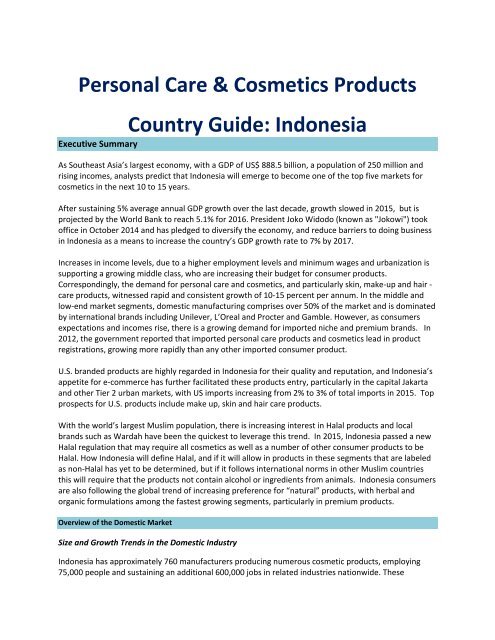Asia Personal Care & Cosmetics Market Guide 2016
AsiaCosmeticsMarketGuide
AsiaCosmeticsMarketGuide
You also want an ePaper? Increase the reach of your titles
YUMPU automatically turns print PDFs into web optimized ePapers that Google loves.
<strong>Personal</strong> <strong>Care</strong> & <strong>Cosmetics</strong> Products<br />
Country <strong>Guide</strong>: Indonesia<br />
Executive Summary<br />
As Southeast <strong>Asia</strong>’s largest economy, with a GDP of US$ 888.5 billion, a population of 250 million and<br />
rising incomes, analysts predict that Indonesia will emerge to become one of the top five markets for<br />
cosmetics in the next 10 to 15 years.<br />
After sustaining 5% average annual GDP growth over the last decade, growth slowed in 2015, but is<br />
projected by the World Bank to reach 5.1% for <strong>2016</strong>. President Joko Widodo (known as "Jokowi") took<br />
office in October 2014 and has pledged to diversify the economy, and reduce barriers to doing business<br />
in Indonesia as a means to increase the country’s GDP growth rate to 7% by 2017.<br />
Increases in income levels, due to a higher employment levels and minimum wages and urbanization is<br />
supporting a growing middle class, who are increasing their budget for consumer products.<br />
Correspondingly, the demand for personal care and cosmetics, and particularly skin, make-up and hair -<br />
care products, witnessed rapid and consistent growth of 10-15 percent per annum. In the middle and<br />
low-end market segments, domestic manufacturing comprises over 50% of the market and is dominated<br />
by international brands including Unilever, L’Oreal and Procter and Gamble. However, as consumers<br />
expectations and incomes rise, there is a growing demand for imported niche and premium brands. In<br />
2012, the government reported that imported personal care products and cosmetics lead in product<br />
registrations, growing more rapidly than any other imported consumer product.<br />
U.S. branded products are highly regarded in Indonesia for their quality and reputation, and Indonesia’s<br />
appetite for e-commerce has further facilitated these products entry, particularly in the capital Jakarta<br />
and other Tier 2 urban markets, with US imports increasing from 2% to 3% of total imports in 2015. Top<br />
prospects for U.S. products include make up, skin and hair care products.<br />
With the world’s largest Muslim population, there is increasing interest in Halal products and local<br />
brands such as Wardah have been the quickest to leverage this trend. In 2015, Indonesia passed a new<br />
Halal regulation that may require all cosmetics as well as a number of other consumer products to be<br />
Halal. How Indonesia will define Halal, and if it will allow in products in these segments that are labeled<br />
as non-Halal has yet to be determined, but if it follows international norms in other Muslim countries<br />
this will require that the products not contain alcohol or ingredients from animals. Indonesia consumers<br />
are also following the global trend of increasing preference for “natural” products, with herbal and<br />
organic formulations among the fastest growing segments, particularly in premium products.<br />
Overview of the Domestic <strong>Market</strong><br />
Size and Growth Trends in the Domestic Industry<br />
Indonesia has approximately 760 manufacturers producing numerous cosmetic products, employing<br />
75,000 people and sustaining an additional 600,000 jobs in related industries nationwide. These

















